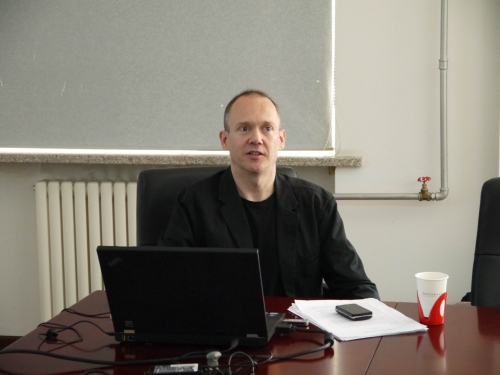- IHNS held the 7th Youth Academic Salon
The seventh Youth Academic Salon was held in conference room 209 of IHNS, 28th March, 2014. Dr. Per Högselius gave a lecture entitled Reinterpreting the History of Atomic Energy: From Nuclear Physics to Hydraulic Engineering. The salon was chaired by Youth Pro. GUO Jinhai.
Per’s lecture challenged mainstream nuclear history narratives, and reinterpreted the history of nuclear energy as a history of water – and the history of nuclear disasters as a history of droughts and floods. The need to guarantee large-scale uninterrupted water flows for cooling nuclear facilities have always been at the very heart of nuclear engineering and safety challenges, and the fear that water supply might be disrupted have long kept nuclear engineers awake at night. The fear of such nuclear droughts led planners and engineers to locate most of the world’s nuclear facilities next to the seas and major river estuaries, where external water supply seemed guaranteed. However, as shown most dramatically at Fukushima in 2011, this made many nuclear power plants vulnerable to flooding. Moreover, numerous nuclear facilities have themselves been the source of floods, quantitatively unimpressive but qualitatively devastating as radioactive substances have been released into rivers, lakes, seas and groundwater reservoirs. In their massive efforts to prevent nuclear droughts and floods from occurring, nuclear engineers in practice turned into a special category of hydraulic engineers. From this perspective, nuclear power is not necessarily as “new” a technology as it might seem at first glance. The “nuclear age”, to the extent that it can be said to have materialized, is fundamentally a hydraulic age, and as such it draws heavily on experience gathered from hydraulic societies in the past. These historical affinities become particularly visible in times of crisis.
Per Högselius is Associate Professor at the Division of History of Science, Technology and Environment at KTH Royal Institute of Technology, Stockholm, Sweden, and currently a Young International Scientist at the Institute for the History of Natural Sciences at the Chinese Academy of Sciences. He holds an MSc degree in Engineering Physics, a PhD degree in Innovation Studies, and a Docent (habilitation) degree in History of Science and Technology. His research primarily focuses on the history of energy and infrastructures in international perspective. His latest book is the freshly published Red Gas: Russia and the Origins of European Energy Dependence (Palgrave Macmillan Transnational History Series, 2013).





